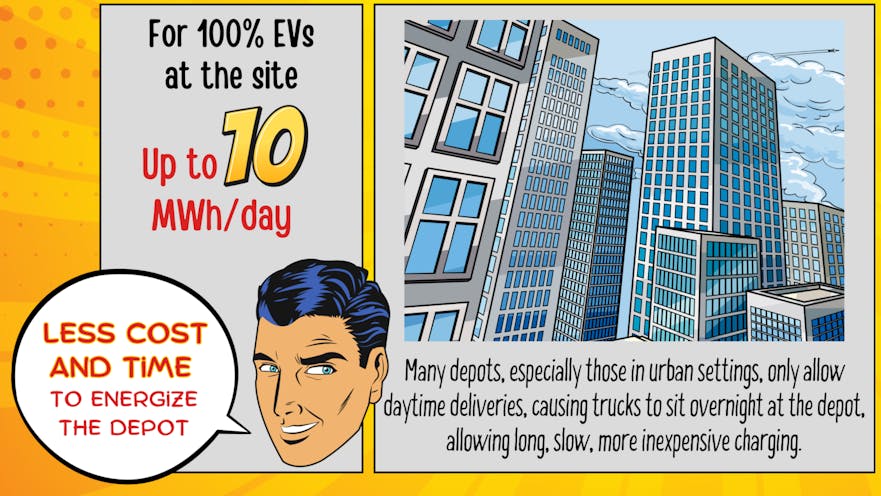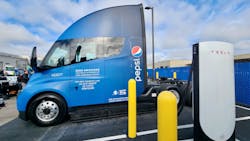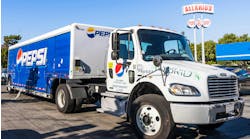Small trucking depots are ripe for electrification, while larger distribution centers need upgraded electrical grids to power future fleet operations, according to the North American Council for Freight Efficiency's latest findings. The findings include the first third-party report on the performance of Tesla Semi EVs in real-world fleet operations.
Small depots operating smaller EVs, such as vans, medium-duty trucks, and a few heavy-duty could be electrified more quickly, according to Mike Roeth, NACFE's executive director. "But this challenge of getting power to the site is big," he told FleetOwner. "It's bigger than we thought. It's more challenging than we thought."
A lot of that challenge is due to utility companies' diligence to ensure that they are able to supply enough energy to power larger fleets without causing brownouts for their other customers. But that is less of a problem for what Roeth called "small energy depots" operating fewer trucks.
NACFE recently shared top-level findings from its latest Run on Less study, which focused on how several electrified trucking depots operate. On Thursday, Nov. 9, Roeth, his team, and some Run on Less fleet leaders visited the White House for a day-long meeting to discuss trucking electrification and learn more about the administration's work on the hub charging corridor.
See also: 3 types of commercial EV customers: Which are you?
Run on Less Electric–Depot was NACFE's fourth efficiency study of real-world trucking operations. It is the council's second efficiency study on battery-electric commercial vehicles. In 2021, NACFE found that yard tractors, medium-duty trucks, vans, and some regional heavy-duty operations were ready for electrification.
"For those small energy depots, we're saying, 'Act now, go.' As for the large energy depots—and we're skipping over mediums stuck between small and large—but at the large energy depots, the trucks are getting more range. The Tesla Semi taught us that these trucks could do 400, 500 miles."
However, running 50 or more heavy-duty EVs at larger depots is becoming "more possible," Roeth explained. But the electric grid is a hurdle. At one of the larger depots NACFE studied, the fleet used up to 10 megawatts—enough energy to power 10,000 homes daily.
Key findings on fleet electrification potential
With colorful, comic book-like graphics, NACFE shared early findings for the latest Run on Nov. 8. The organization noted that while it's still taking a long time to install charging infrastructure at heavy-duty trucking depots, there have been significant improvements to electric trucks and charging technology since the 2021 Run.
NACFE launched the latest three-week Run on Less demonstration with RMI on Sept. 11. The organization studied 10 depots operating 291 electric trucks. NACFE focused on the performance of 22 of those vehicles throughout the 18-day study.
See also: First of Daimler's new medium-duty EV trucks reach U.S. shores
The nearly three-week study showed NACFE organizers the potential, as the 22 EVs were as reliable in the first days as they were in the final days, according to Roeth. "Our early findings fell into six broad categories," he said. "The data collected throughout the 18 days of the Run validated those early findings, which we expect will give fleets confidence in moving toward wider use of battery electric vehicles."
Six key findings have been identified by NACFE:
- Small depots are ready for electrification now, and electrification at large depots is gaining momentum.
- There have been considerable improvements in trucks and chargers since Run on Less—Electric in 2021.
- The industry needs cost and weight reductions to improve the total cost of ownership.
- The range can be extended with multiple charges per shift at the depot and en route.
- It's still taking too long for power delivery and infrastructure to be installed, driving portable/temporary charging.
- The diversity, passion, and capability of the people involved are helping to scale the adoption of electric trucks.
Roeth said that the study found that 49% of the people they met at depot sites were women and people of color. "That's an extraordinary level of inclusion that we haven't seen in this industry," he said.
Electrifying: From light-duty vans to Tesla Semis
According to NACFE, the Run also found good news for fleet uptime. Roeth said that 22 electric trucks studied performed as expected, with some exceeding expectations. For example, the Tesla Semis deployed at PepsiCo's Sacramento Beverages depot completed 410 miles on a single charge and 1,076 miles in 24 hours, enabled by fast 750 kW charging at various points during the day.
Roeth told FleetOwner that the Tesla heavy-duty tractors appear to be living up to the lofty expectations created when they were first announced in 2017. "The truck appears to be able to do 400 miles heavy-loaded, maybe 500 miles empty to light-loaded," he said. "Pepsi and Frito-Lay are the only two fleets that have them. I call the trucks and the data from the Run 'the art of the probable.'"
See also: Two fleets weigh in on their EV transition progress
The depots in the study did not experience any significant loss of power or uptime of the charging systems during the 18 days, according to NACFE.
"We also learned that improvements in the trucks, the charging infrastructure, and well-thought-out implementation plans are critical to delivering the benefits of electric trucks on a wider scale," Roeth adds.
The Run featured various electric trucks operating in a full range of duty cycles.
- Frito-Lay in Queens, New York: Two Ford E-Transit vans operating in urban delivery.
- OK Produce in Fresno, California: A Freightliner eCascadia and an Orange EV yard tractor for local fruit and vegetable deliveries and terminal tractor applications.
- Penske in Ontario, California: a light-duty GM BrightDrop, a medium-duty Navistar eMV, and a heavy-duty Freightliner eCascadia.
- PepsiCo in Sacramento, California: two Tesla Semis in heavy-load, long-haul transport operations.
- Performance Team in Commerce, California: Two heavy-duty Volvo VNR Electrics conducting short-haul routes.
- Purolator in Richmond, British Columbia: A Class 6 Motiv step van and a Ford E-Transit in business and residential package delivery.
- Schneider in South El Monte, California: Two Freightliner eCascadias operating in slip-seated drayage.
- UPS in Compton, California: A Freightliner Custom Chassis MT50e last-mile step van and a Freightliner eCascadia operating in middle-mile duty cycles.
- US Foods in La Mirada, California: Two Freightliner eCascadias operating in food delivery applications.
- WattEV in Long Beach, California: A BYD 8TT tractor and a Nikola Tre BEV tractor operating at the Port of Long Beach.
All trucks were tracked using Geotab technology, capturing total miles driven, miles per day, deliveries per day, battery state of charge, use of regenerative braking, and other metrics. A data set is available for download at NACFE's website.
Click the Start Slideshow button at the top of this page to view NACFE's colorful findings from the 2023 Run on Less as a slideshow.





